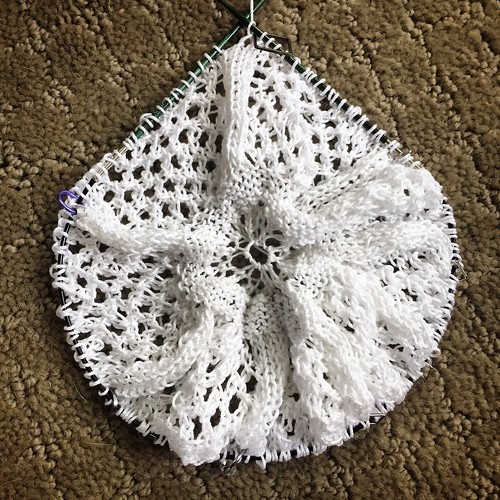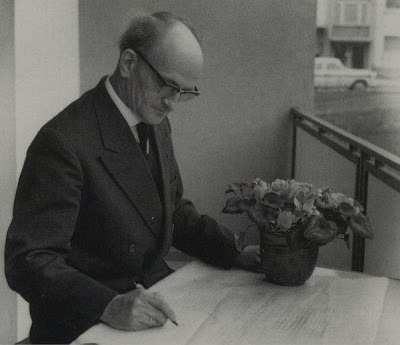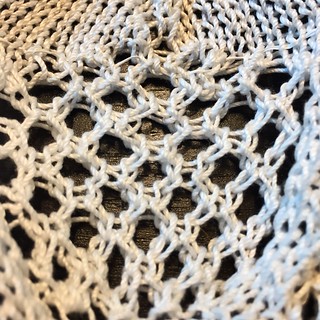Tuesday, June 20, 2017
Doppelumschlägen
My latest knitting adventure involves intricate lace patterns. Written in German. Help.
For a while I've wanted to knit a fancy lace design by the German lace designer Herbert Niebling (1905-1966), a man who needs a Wikipedia page if anyone does. He churned out hundreds of intricate knitting patterns for tablecloths and doilies in the mid-20th century. Many of the designs feature stylized flowers and plants. Reading through their names is like reading a German botany book -- Eiche (Oak), Ahornblatt (Maple Leaf), Hängeblume (Hanging Flower), Löwenzahn (Dandelion), Erdbeere (Strawberry), Tannenzapfen (Pine Cone) -- the list goes on and on. Then, randomly, there are patterns with people's names attached to them. Some of these patterns are enormous and would take months of painstaking work. Some are just tiny little coaster-sized things. I kind of want to knit them all, but can't figure out how any human being could ever knit all these in a lifetime, much less design them, too.
I decided that for my first foray, I'd settle on something smaller than a tablecloth, but which I could still trot out as a centerpiece for nice dinners. Having something like this, I assume, will make me want to host nice dinners. I decided on a pattern called "Georg," which is oval-shaped and doesn't really have to fit over a piece of furniture -- it just just has to lie flat on top of it. Plus, a knitter in Ravelry had already made a beautiful example and had basically translated parts of the pattern for English knitters. Decision made!
I got some crochet thread and some size US0 (2mm) needles and got to work. And then started over. And then started over again. I was having trouble with the double yarnovers in the pattern and dropping stitches left and right. I finally managed to fall into a rhythm, but it was a bit of a struggle.
After finishing the 40th round, I finally dug around on some online forums to find out more about double yarn overs -- for non-knitters, this is wrapping the yarn around the right needle twice. Very simple. The effect is to create a hole in the fabric, which is kind of lace's thing. But working these loops on the next row is another matter. I just knit into them again, which created a strange string that draped across. Since the row after that involved decreases that pulled the previously-created holes to one side or another, I didn't really think anything about it. It looked okay to me. But reading today, I found that everyone one in the lace-knitting universe knows that you don't just knit into those two loops. You either knit then purl, or purl then knit, or knit then knit into the back of the next loop. But one thing they all agreed on: one simply does not knit into a double yarnover twice on the next row. See the triple-strand ladders running between the honeycomb-like holes in this detail? That's what happens when you do what I did. Why didn't anyone tell me this?
Well, apparently, Herbert Niebling did. Right there in his instructions, he says Auf jede Musterrd. folgt 1 rd. rechts, in der man nur aus den Doppelumschlägen 1 M. link 1 M. rechts strickt, which Google Translate kicks out as "On every pattern follows 1 approx.(?) on the right, in which one knit 1 st on each side from the double turn." I've learned that the German words for knit and purl translate as "right" and "left," so "knit one stitch on each side from the double turn" is basically knit and purl into the double yarnover.
So now my favorite new German knitting vocabulary word is Doppelumschlägen (double yarnover). And now I know what to do with these. So it looks like I'll ripping back to row 11 again. In the meantime, I need to get back to lurking on the forums to see what other tidbits about lace knitting I don't know. Nothing like learning a whole new language in a whole new language.
Labels:
Lace
Subscribe to:
Post Comments (Atom)




Oh my goodness! I don't think I'm brave enough to tackle proper lacework in English, never mind German. I will follow your German knitting adventures with interest! My German skills are limited to "schwimmveste unter ihrem sitz" which I picked up on a Lufthansa flight.
ReplyDeleteSlightly related, I have ordered a Japanese men's knitting pattern book with the aim of following a sweater pattern. Luckily Japanese knitting patterns mostly use charts and I've found a blog which explains one of the patterns in the book.
Good luck!
Doppelumschlägen! Way to go global.
ReplyDelete